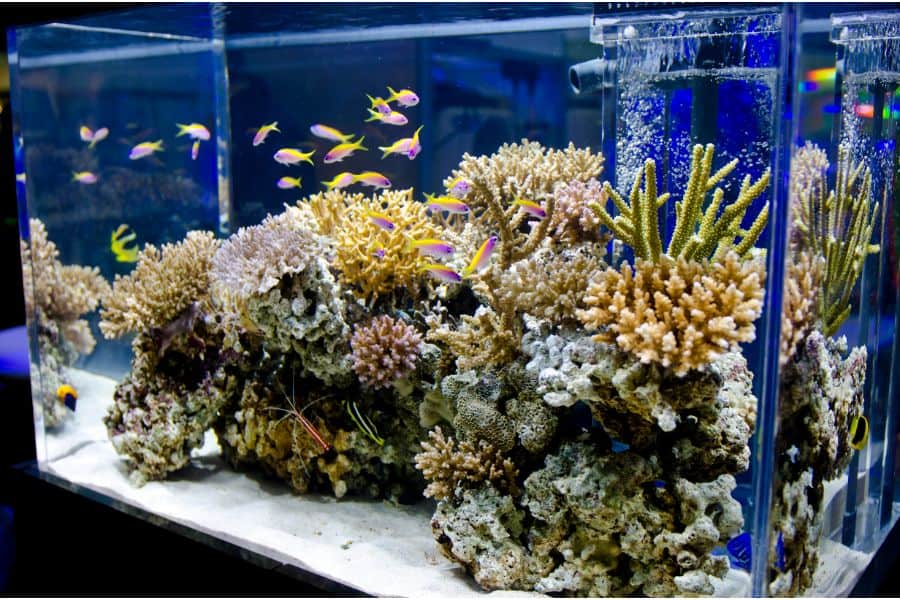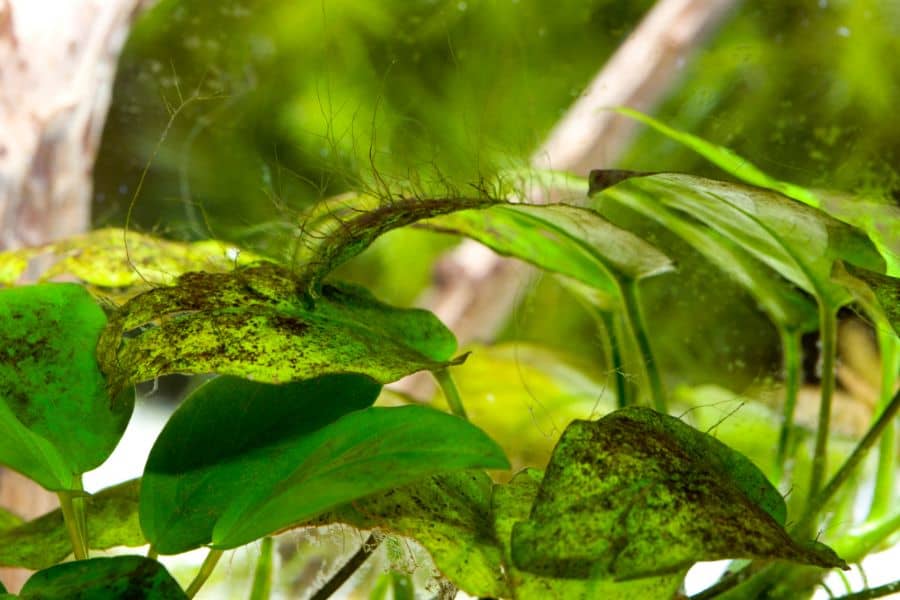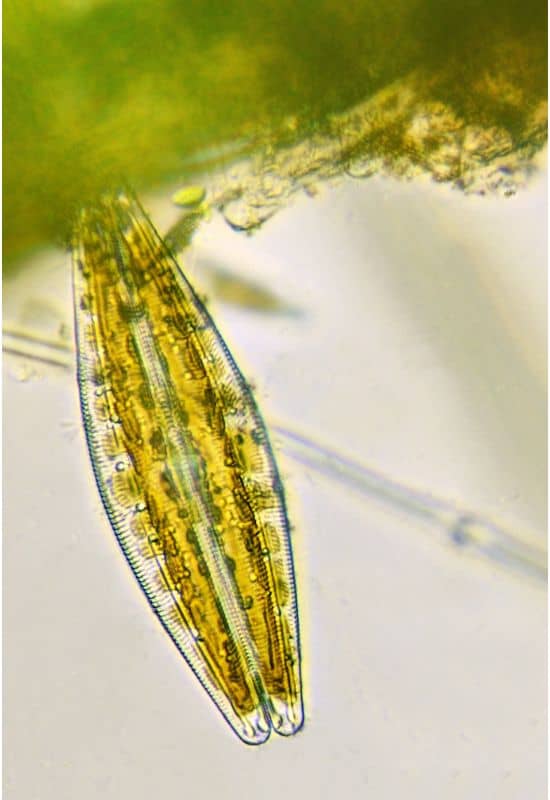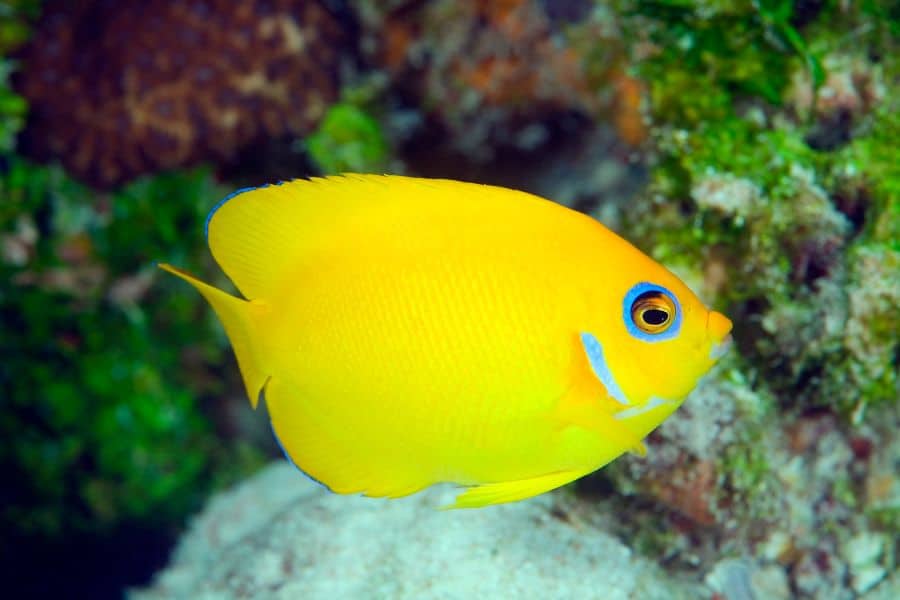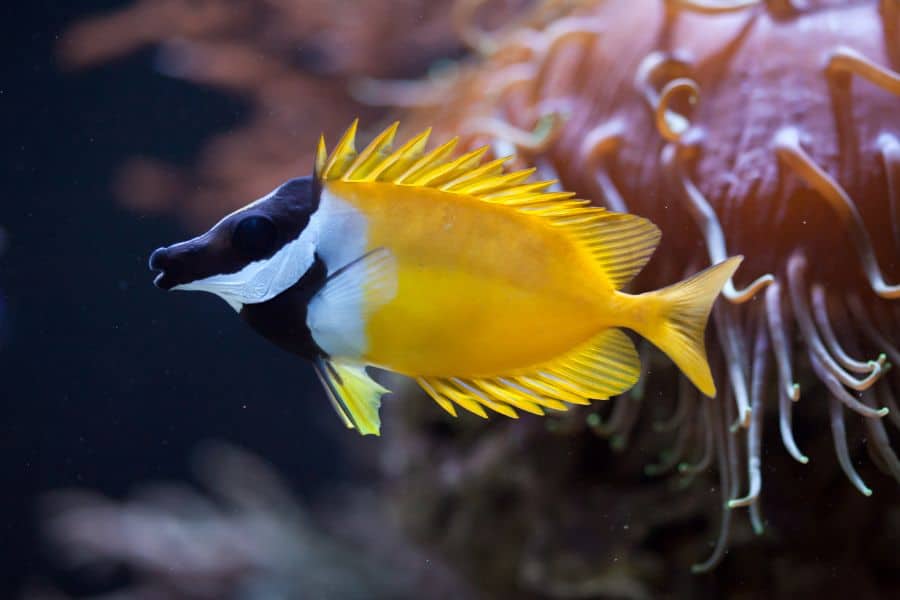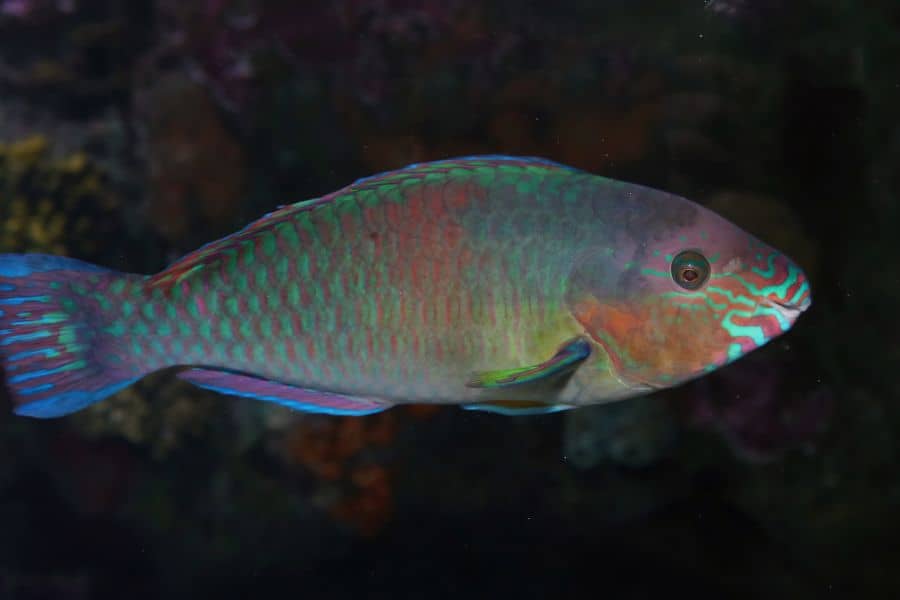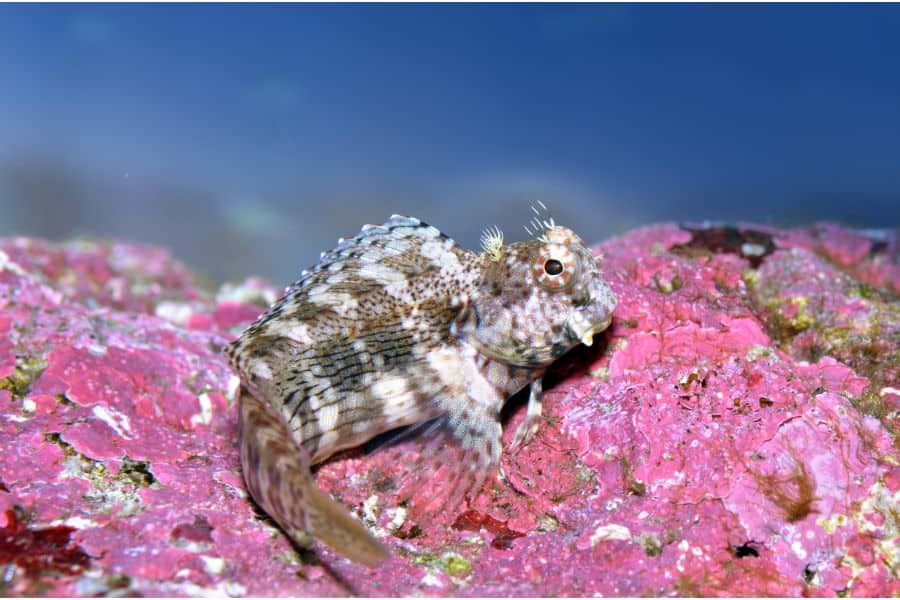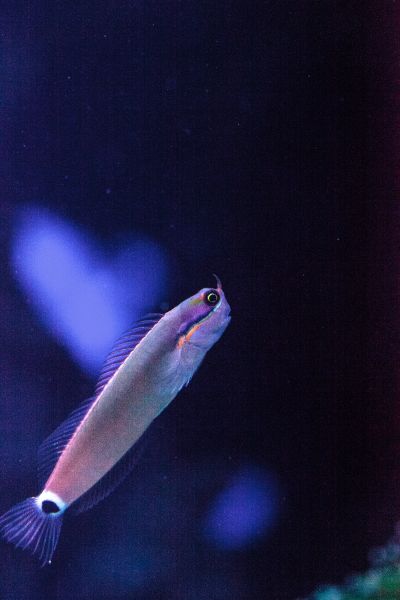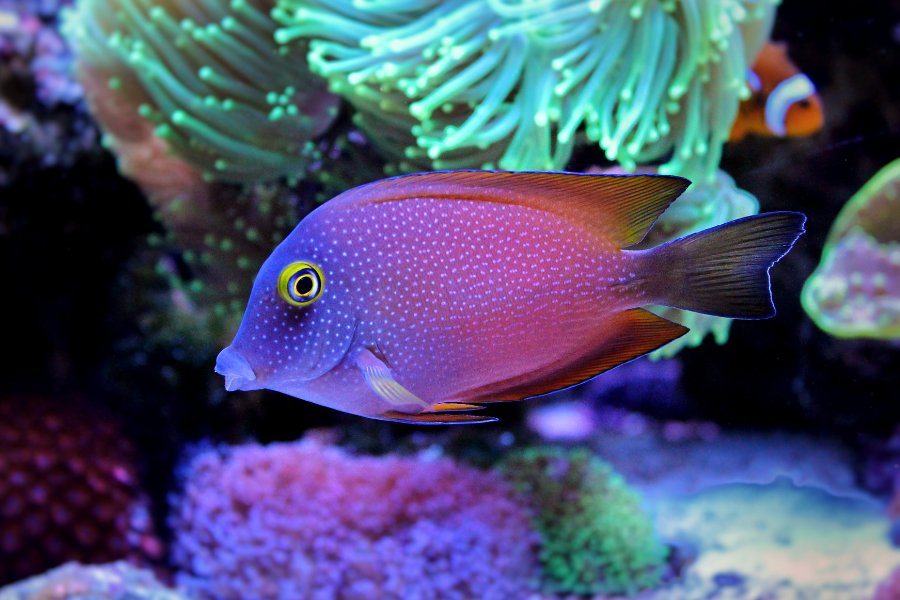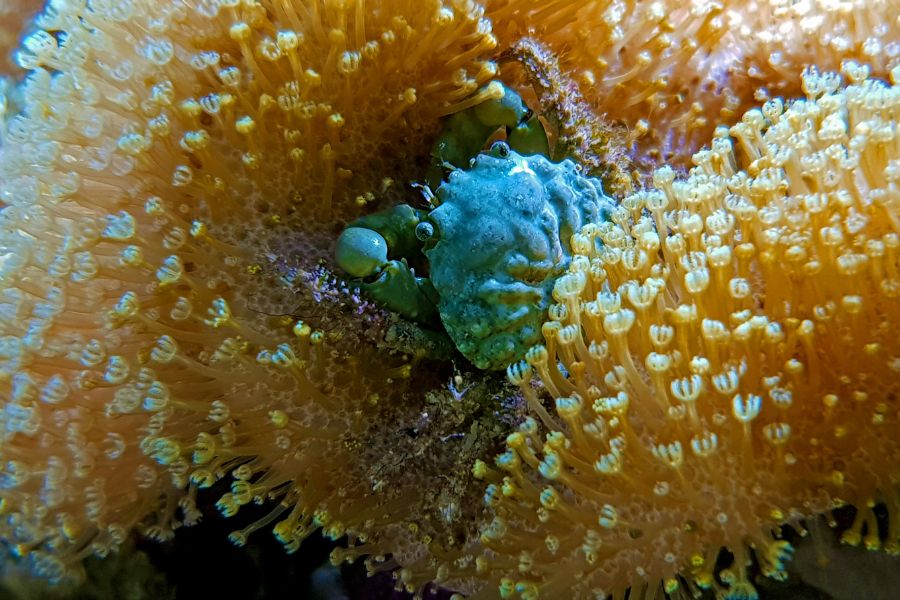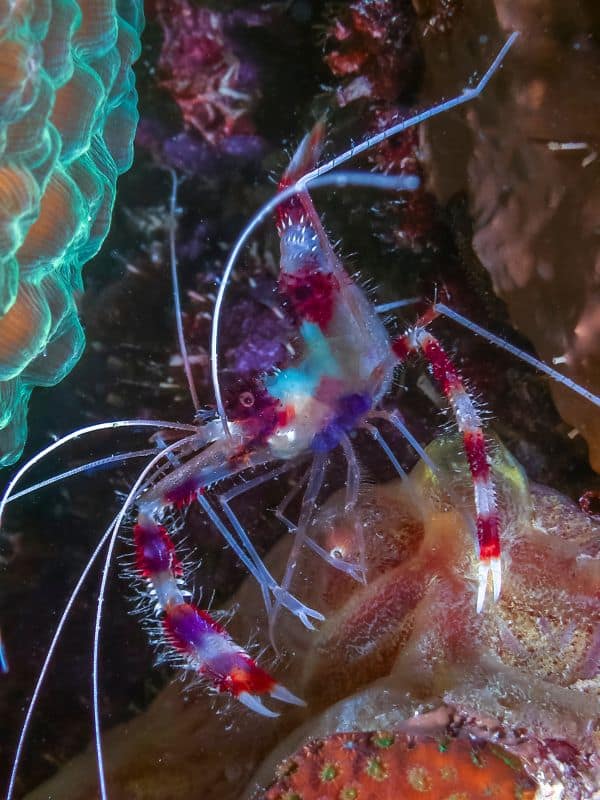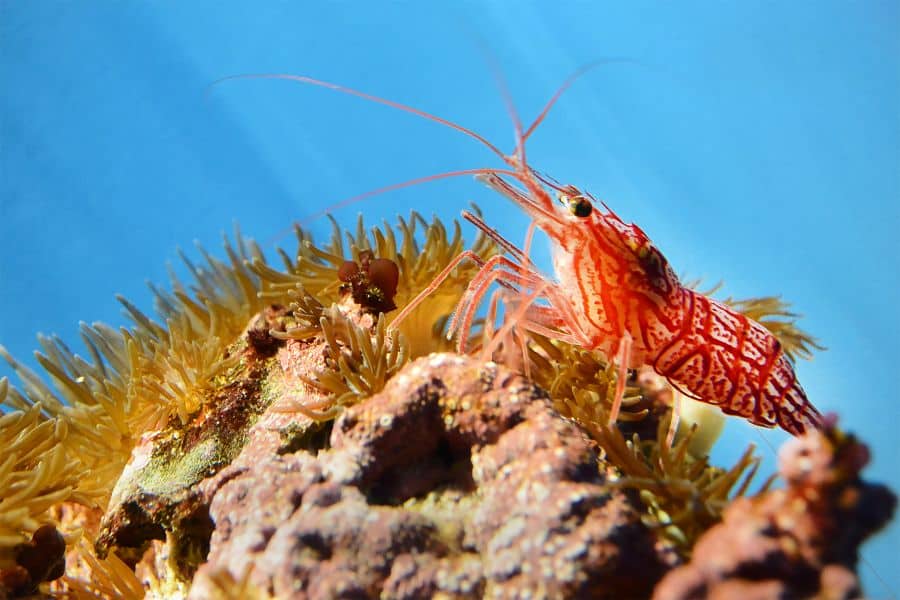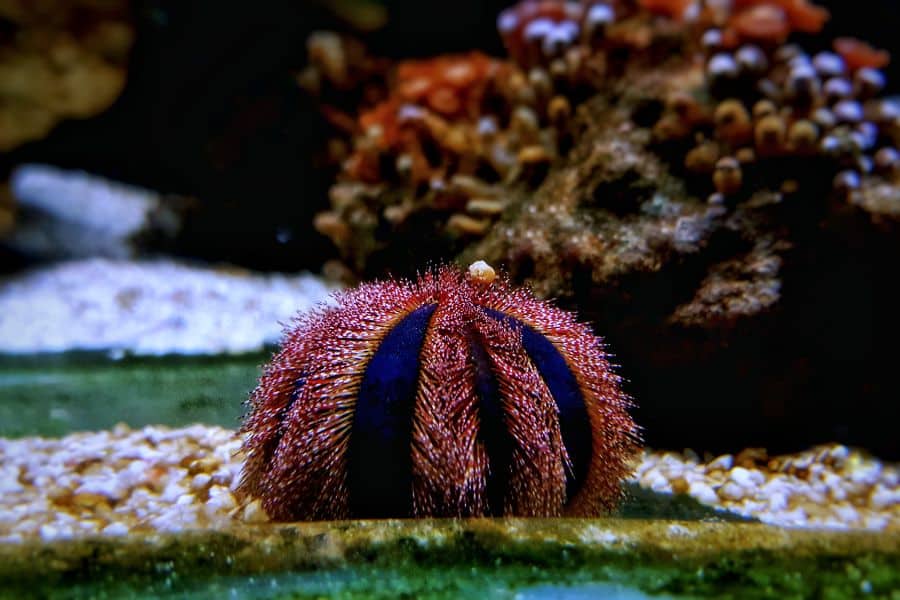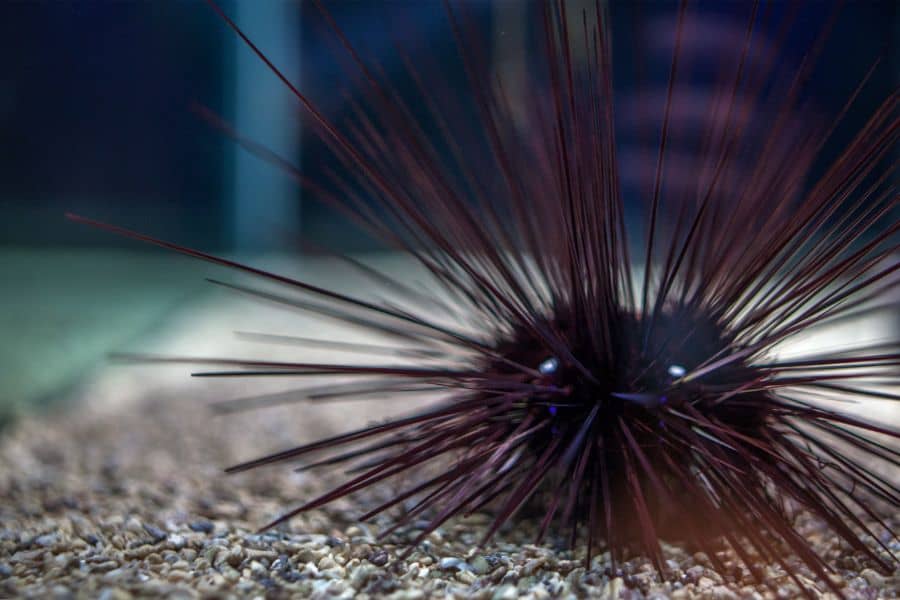Setting up and maintaining a saltwater aquarium is generally more difficult than freshwater tanks since it requires experience, effort and equipment.
Without these 3 E’s, you may not achieve the pristine conditions saltwater tanks are known for, and the growth of unwanted algae is often the consequence.
But how about stocking your saltwater tank with algae eaters? In this way, you are hitting two birds with one stone since these organisms can become a tank attraction while consuming algae and making your tank clean.
Join us in this article as we present to you the best saltwater algae eaters and their favorite food items.
Types of Algae in Saltwater Tanks
Although they can eat any algae type, the Saltwater Algae Eaters we are presenting here have a preference, and they tend to focus and target on consuming one or two (or even more) species of algae.
It is, therefore, significant to know the common types of algae that may grow in your saltwater tank so that you can use and keep the appropriate Algae Eater.
Hair Algae
Also known as Filamentous Algae, Hair Algae usually grows into long fine green strands that intertwine like hair. Initially, they are free-floating, but will soon attach themselves to any surface.
Hair Algae is unpleasant to see. Once fully blooming, they are hard to control and may cover the entire surface of the object they are attached to. The only way to get rid of them is to pick them out manually by hand.
While cleaning your tank against Hair Algae, you should also be aware and reflect that their presence indicates poor water filtration.
Bubble Algae
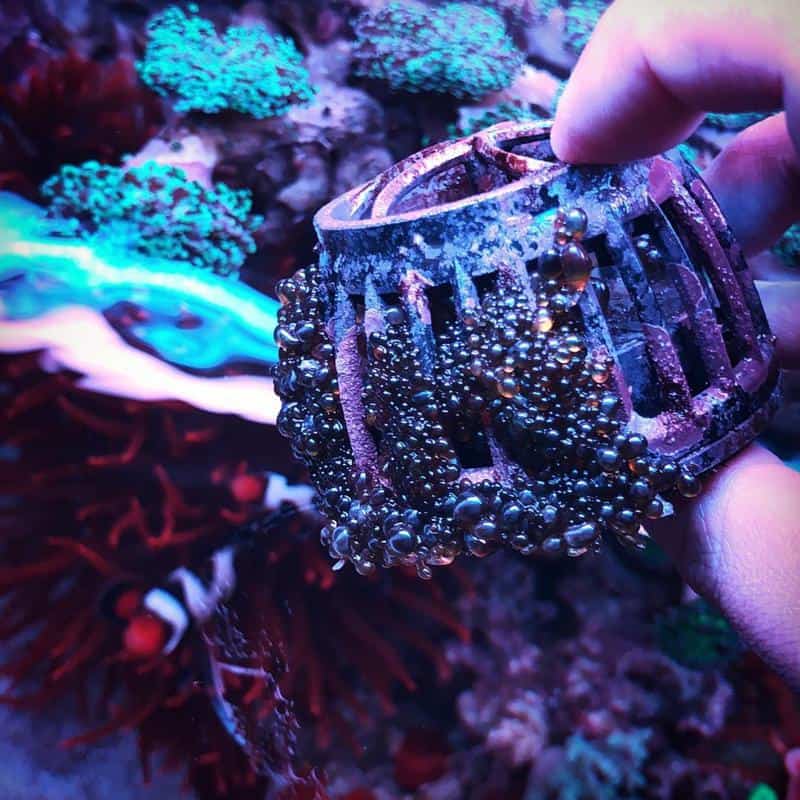
As the name suggests, the Bubble Algae has a distinct round shape with air encased in a green cell wall resembling a blister.
Although they are not super fast growers, they are hardy and attach themselves firmly to an object, making them hard to remove.
Managing the removal of Bubble Algae can be tricky and requires utmost care. Remember, if you accidentally burst their inflated case, they can release their reproductive material which can form into new Bubble Algae.
Film Algae
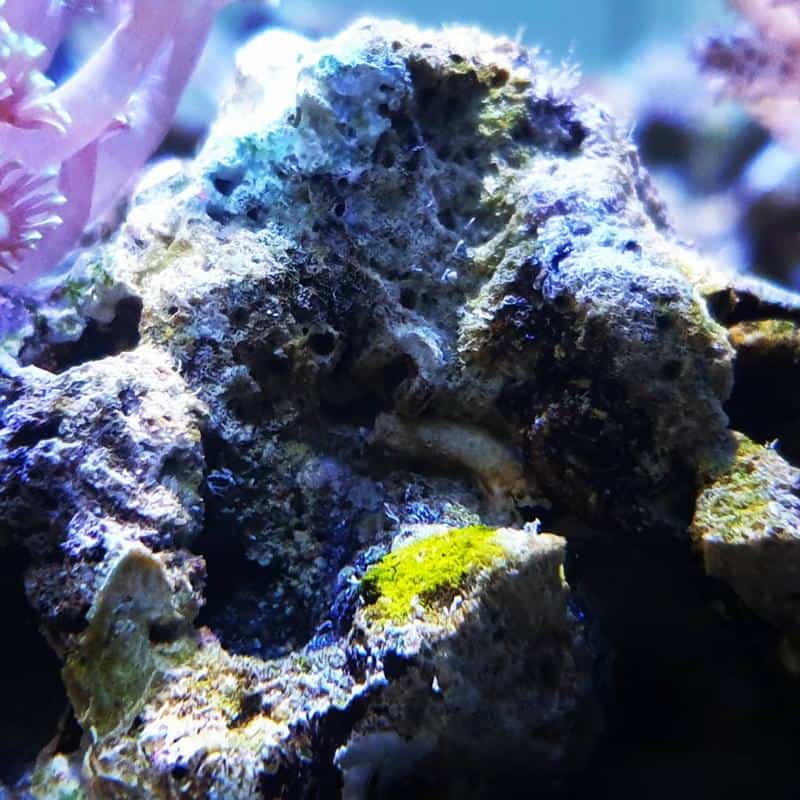
If Bubble Algae are hard to remove, it is the opposite for the Film Algae. With a simple wipe of cloth, these green-colored algae can easily be removed from where they attach (commonly in glass and decors).
Diatoms
Algae are commonly associated with the green color, but not all the time. In some cases, it can be in the form of a brown film brought by the algal growth of diatoms.
These single-celled microalgae have a glass shell made of silica. When they grow in numbers and clump together, they form a brown sheet that sticks to any surface in your aquarium.
While being photosynthetic, they can use minerals and nutrients (especially nitrates and silica) for cell development. It is why their presence is also used to indicate an unstable water chemistry.
Red Slime Algae
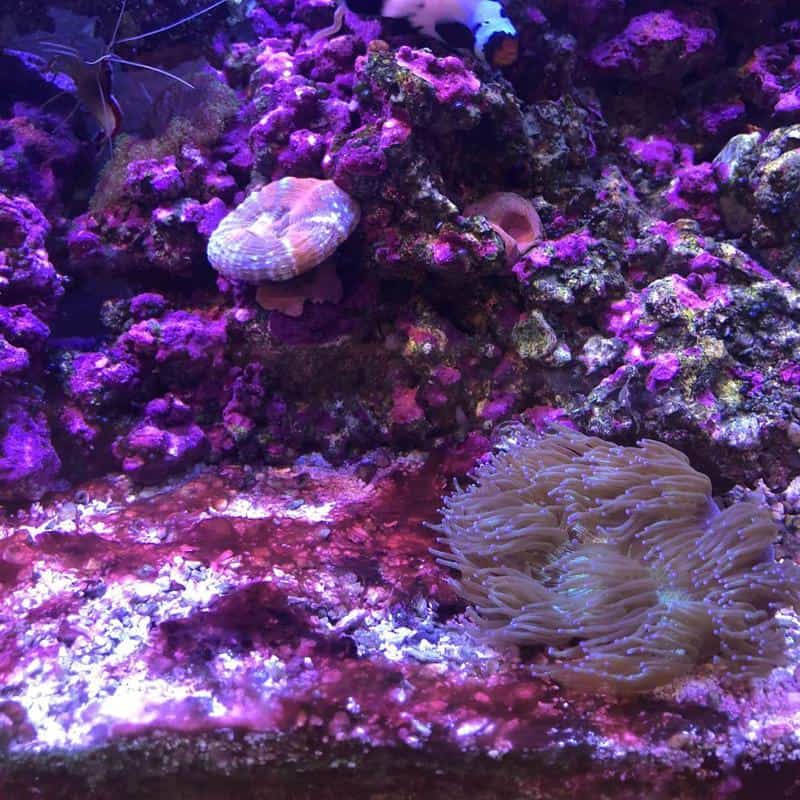
Red Slime Algae is a type of cyanobacteria that clusters into a purple or red-colored film.
During perfect conditions (like low water flow and low dissolved oxygen content) they rapidly multiply, produce a distinct pungent odor, and their biological film can suffocate corals and other non-moving organisms.
Coralline Algae
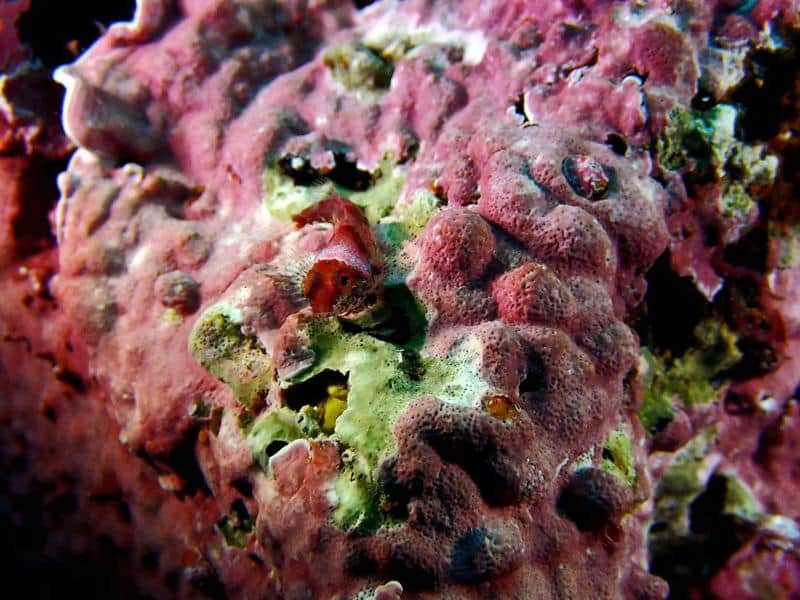
For the untrained eye, Coralline Algae is beautiful and pleasing to the eyes. But for expert aquarists, they are still the unwanted algae we all hate, especially since their growth indicates unstable water conditions.
This pink-colored algae has an encrusting growth similar to those of corals. Growing only a few centimeters a year, Coralline Algae are slow growers. If you see them growing in your aquarium, it can only mean one thing: your water chemistry has long been unstable.
The Best Saltwater Algae Eaters: At a Glance
| Name | Preferred Algae Consumption | |||||
| Hair Algae | Bubble Algae | Film Algae | Diatom | Red Slime Algae | Coralline Algae | |
|
1. Fish |
||||||
| Lemon Peel Angelfish | ✓ | ✓ | ||||
| Foxface | ✓ | ✓ | ||||
| Quoyi Parrotfish | ✓ | ✓ | ||||
| Lawnmower Blenny | ✓ | ✓ | ✓ | ✓ | ✓ | |
| Tailspot Blenny | ✓ | ✓ | ||||
| Kole Tang | ✓ | ✓ | ||||
|
2. Shrimps and Crabs |
||||||
| Emerald Crab | ✓ | ✓ | ||||
| Coral Banded Shrimp | ✓ | ✓ | ✓ | |||
| Peppermint Shrimp | ✓ | ✓ | ||||
|
3. Snails |
||||||
| Astraea Snail | ✓ | ✓ | ✓ | |||
| Mexican Turbo Snail | ✓ | ✓ | ✓ | |||
| Cerith Snail | ✓ | ✓ | ||||
|
4. Sea Urchin |
||||||
| Tuxedo Urchin | ✓ | ✓ | ||||
| Pincushion Urchin | ✓ | ✓ | ||||
| Diadema Sea Urchin | ✓ | ✓ | ✓ | |||
Fish
There are over 20,000 species of saltwater fish worldwide. However, only a fraction have feeding adaptations that allow them to eat algae, and most of them are reef-associated fish.
Lemon Peel Angelfish
Due to its stunning yellow color and active lifestyle, the Lemon Peel Angelfish (Centropyge flavissima) is one of the popular saltwater aquarium fish.
Despite being an omnivore, algae are still part of their diet. When they are kept in their ideal 70-gallon tank, you can expect them to effectively control the growth of hair algae.
There are three things that you need to remember in keeping Lemon Peel Angelfish.
First, you need to give them feed supplements as relying solely on algae is not sufficient for their dietary needs. Second, be cautious when you have corals as they sometimes nip on their polyps. And lastly, they are sexually dichromatic which means that the males are slightly different from the females. While their eyes are surrounded by a blue circular outline, the color is more intense in males.
Foxface
Keeping Foxface is almost a guarantee that your saltwater aquarium will be free from hair algae. While they eat other types of algae, their preference is hair algae, which this 25 cm long type of rabbitfish is known to chew up on them.
They are also great for beginners since they are hardy and can resist minor bacterial infections due to their slimy coats on the skin.
Caution: Do not use your hands in handling a Foxface. Their fin spines are loaded with venom and will give you a nasty if accidentally touched. Always use a fish net.
Quoyi Parrotfish
There are a few reef fish that specialize in eating coralline algae and one of them is the Quoyi Parrotfish (Scarus quoyi).
In the wild, Quoyi Parrotfish are known to munch in the exoskeleton of corals and they will have no difficulty consuming the hardy growth of a coralline algae. This is due to their beak-like jaw that is powerful enough to bite and scrape coralline algae.
Fun fact: Quoyi Parrotfish are protogynous hermaphrodites. This means that they are females when juveniles and change to males when they mature.
Lawnmower Blenny
Even if you place Saltwater Algae Eaters, it is not guaranteed that all sections in your tank will be free from algae. Algae can still grow, especially in tight spaces. But with the Lawnmower Blenny (Salaria fasciatus), they can control algae growth even in hard-to-reach areas.
Oftentimes, you can see a Lawnmower Blenny lying motionless on the substrate. But don’t be fooled as if they are doing nothing. The fact is they are scouting your tank for the best algae to feed upon. This 10 cm long fish can eat any type of algae, except hair algae which are not appetizing for them.
Be cautious in keeping your Lawnmower Blenny with corals as they are known to occasionally nip on their polyps.
Tailspot Blenny
The Tailspot Blenny (Ecsenius stigmatura) is the perfect Saltwater Algae Eater if your tank has a lot of tiny hard-to-reach areas. With their 8 cm long bodies, they can penetrate tight spaces and consume algae growing on them.
Many aquarists have considered Tailspot Blenny as the perfect compliment for your Lawnmower Blenny. Aside from consuming leftover algae, the Tailspot Blenny will devour Hair Algae which is not consumed by your Lawnmower Blenny.
While they can easily be identified through their vibrant orange body that has a black spot on their tail, do not be surprised if they change color. When threatened, they mimic the appearance of nearby large fish and pretend to be aggressive.
Caution: The Tailspot Blenny is capable of jumping out of the water. So, be mindful of placing tank lids to prevent them from escaping.
Kole Tang
Maintaining a 100-gallon saltwater tank with a thick substrate requires time and effort. If you have this kind of set-up and want it to be algae-free, consider having the Kole Tang (Ctenochaetus strigosus).
Also known as the Bristletooth Tang, this Hawaiian native Surgeonfish has a voracious appetite for algae. Using their comb-like teeth, they scrape diatoms and filamentous algae growing in the substrate and rocky surfaces.
When not in feeding mode, Kole Tangs are active swimmers and they require ample swimming space. If you keep several of them in a 100-gallon tank, they create a magically-inspired aesthetic as their unique color pattern resembles those of Hawaiian sorcerers.
Related: Most Popular Tang Fish Types
Shrimps and Crabs
Marine crustaceans (like Crabs and Shrimps) are known scavengers that eat any food (dead or alive) found in the substrate.
Aside from their grazing behavior, they are also known to filter feed. They can vacuum out algae that are not just stuck in the glass or in any object, but pull out those that are suspended in midwater.
Emerald Crab
If you see some Bubble Algae growing in your tank, don’t wait for it to bloom and prevent its spreading by adding Emerald Crabs (Mithraculus sculptus). Also known as the Green Clinging Crab, they are often found hiding in tight spaces or under rocks.
Even if they are hiding, Emerald Crabs are continuously eating and are always on a constant search for food, like their favorite Bubble Algae.
While Bubble Algae are hard to remove, the front claws of an Emerald Crab are their secret weapon in removing them. This pair of modified legs can tear the algae apart and lead it to the mouth for consumption.
If the amount of Bubble Algae is not sufficient for the cravings of an Emerald Crab, they can go back to the same spot and scrape off the remaining algae parts.
Coral Banded Shrimp
Want to make your saltwater tank algae-free 24/7? Try keeping the Coral Banded Shrimp (Stenopus hispidus).
Most of your Saltwater Algae Eaters will eat algae during the day, and when the sun is down or when you turn off your aquarium light, it is when this 5 to 7 cm long shrimp with an alternating red and white coloration goes to work.
As a nocturnal organism, they become active at night to feed on anything found on the substrate including diatoms, hair, and film algae.
After feeding, you often see their claws wide open giving you the impression that they are aggressive and ready to fight, thus its alternate name – the Boxer Shrimp. While they really are aggressive to fellow shrimps, their boxing position is a way to attract fish to come to them for a quick body clean against dead skin and parasites.
Peppermint Shrimp
Also known as Candy Cane Shrimp, the Peppermint Shrimp (Lysmata wurdemanni) has a translucent body with a reddish-brown coloration like those of a candy cane. This 5 cm long colorful shrimp is one of the many cleaner shrimps that eats detritus and hair algae.
Two things you should need to know in keeping Peppermint Shrimp. First, they need iodine supplements during molting as it facilitates the creation of a new exoskeleton. Second, sometimes you cannot see them during the day as they hide in burrows to prevent them from being eaten by larger fish.
Snails
Snails are one of the best Saltwater Algae Eaters. Although they move slowly, their movement is constant which means that they are also constantly eating algae.
Aside from constant movement, what makes them an effective algae eater is their specialized feeding structure. They have a ribbon-like organ called the radula which are rows of teeth that scrape algae.
Astraea Snail
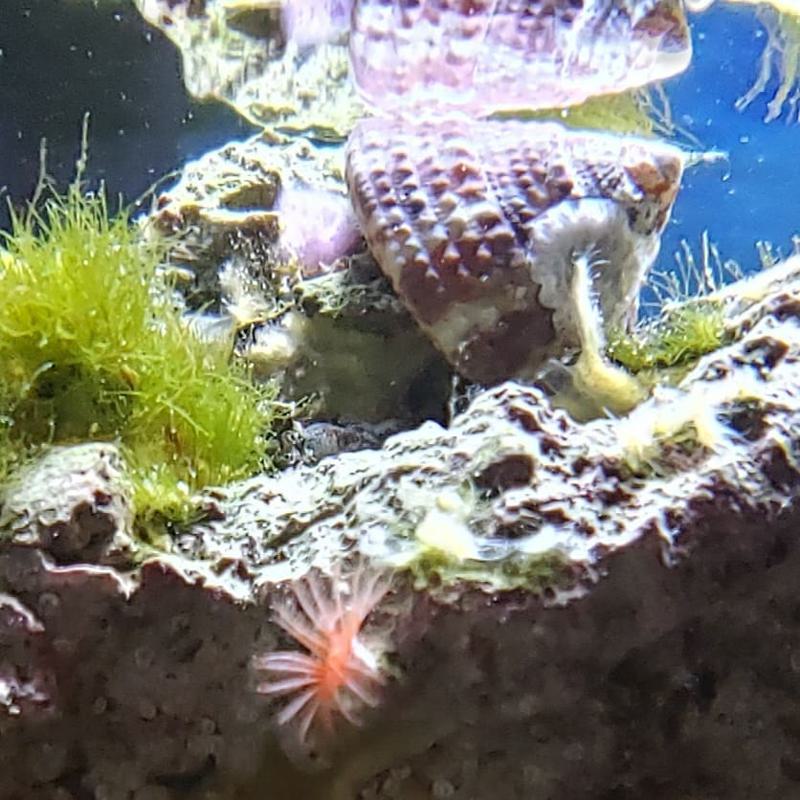
Snails will eat anything that comes on their way. But the Astraea Snail (Lithopoma tectum) crawls to where diatoms, hair, and red slime algae grow, devouring them as they pass and go.
Mexican Turbo Snail
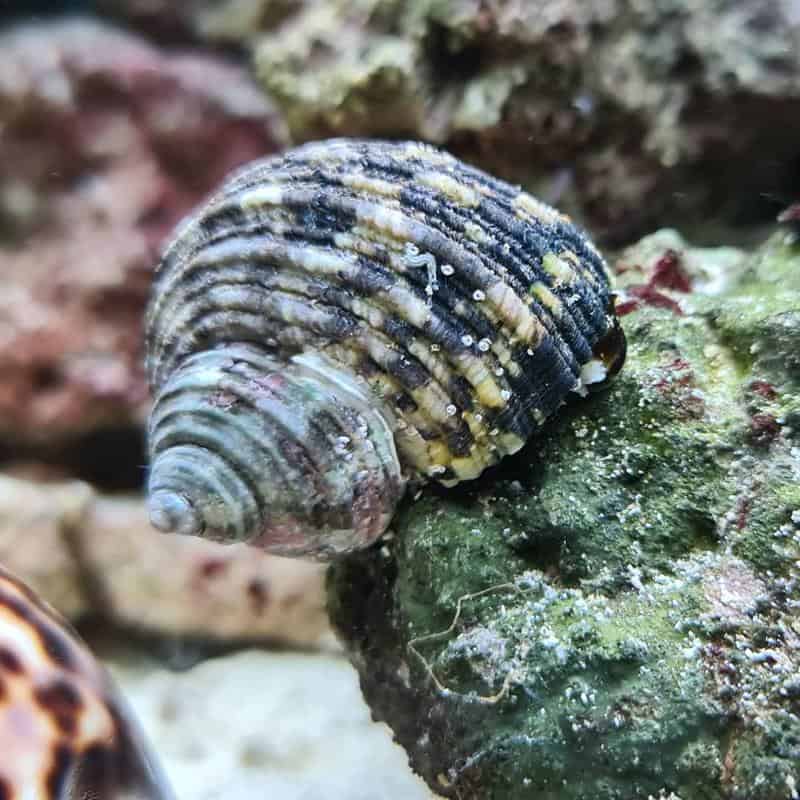
If you’re considering keeping a snail for your large saltwater tank, then take a look at the Mexican Turbo Snail (Turbo fluctuosa). They are herbivores and their radula is highly developed and highly effective in scraping diatoms, hair, and film algae.
Their appetite for algae is voracious. When there is enough supply of algae, they constantly feed and reach their 7 cm maximum length in no time, earning them its alternate name – the Mexican Turbo Grazers.
Cerith Snail
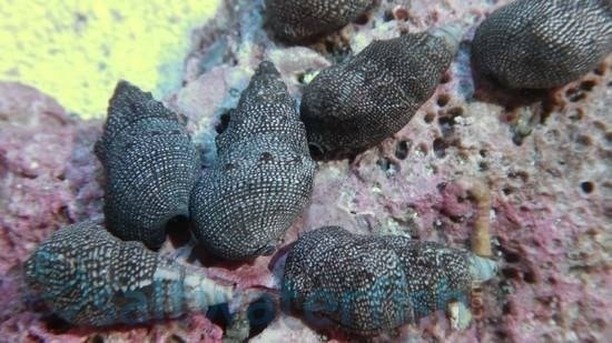
Although they look different from your Mexican Turbo Snail, the Cerith Snail (Cerithium sp.) is their smaller version in terms of consuming algae.
With their small size (5 cm max length), the Cerith Snail is perfect for small marine aquariums (including nano reef tanks) where they specialize in consuming hair and film algae sticking to the glass.
Just be aware that they are capable of reproducing in captivity. Once they multiply in numbers, they can easily be sucked and obstruct your filter system.
Sea Urchin
Especially if their numbers are high, wild Sea Urchins could indicate a bad reef condition. However, in the saltwater aquarium hobby, they are used to add aesthetic diversity and to perform certain biological functions such as consuming unwanted algae.
Their primary anatomical asset in consuming algae can be found on the underside of their body. While they have tube feet to scrape on algae, it is their interlocking teeth that form a beak called Aristotle’s Lantern that does most of the algae cleaning.
Tuxedo Urchin
Have you seen a sea urchin that makes this habit of placing debris on its head? Most probably, you have seen a Tuxedo Urchin (Mespilia globulus).
Their beaks are known to effectively cut off hair and coralline algae. Despite their big appetite for algae, they are slow growers and may take a year to reach their 10 cm maximum size.
Tuxedo Urchin have short red spines arranged in vertical columns in between a blue background, making them aesthetically pleasing to look at.
Pincushion Urchin
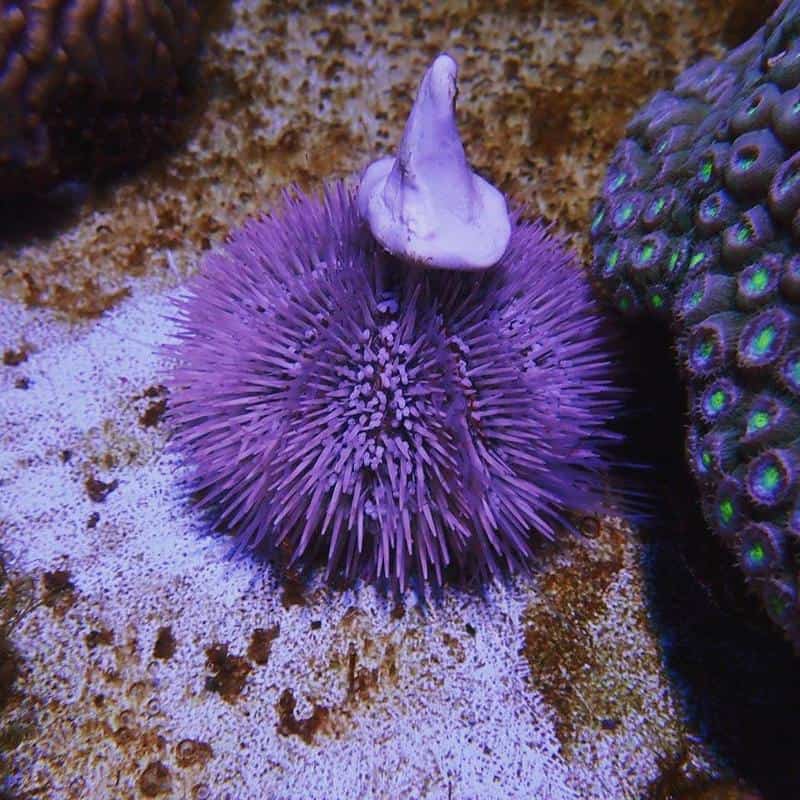
The Pincushion Urchin (Lytechinus variegatus) has all the qualities similar to those with the Tuxedo Urchin, except they move faster and they don’t place small pieces of debris on their head.
Diadema Sea Urchin
Diadema Sea Urchin (Diadema setosum) are commonly encountered in the wild as they are the type of sea urchin we step on and cause foot injury while walking on the shallow shores of a beach.
While they are not aesthetically pleasing as the spines are long, they are highly effective algae eaters and targets in consuming hair, film, and coralline algae in large quantities.
Also Read: Best Freshwater Algae Eaters
Saltwater Algae Eaters: FAQs
Do Clownfish Eat Algae?
Yes. Clownfish are omnivores, and algae are part of their diet. However, you cannot rely on them as agents in controlling algae growth. Algae are only a tiny part of their diet, and most of their food items are confined within the space they are living with their host sea anemone.
Do Carnivorous Fish Eat Algae?
No. Algae is not a part of a carnivorous fish diet. But they can accidentally eat algae. Although you can still incorporate plant-based protein in their feed supplements, we do not recommend it. Remember that the digestive system of carnivorous fish is not designed to process and digest plant matter.
Can I Place an Algae Eater to Consume an Algae-Infested Tank?
Yes, but maybe it is too late. Algae eaters are best kept as an agent to control the excess algae growth. When you place them in an already infested tank, they still do eat algae, but they can no longer keep up and decrease the density.
Final Thoughts
Saltwater Algae Eaters do really consume unwanted algae. However, we should not rely on them as the main agent in controlling algae growth. Remember, nothing beats proper tank maintenance, which for us, is more effective than relying solely on Saltwater Algae Eaters.
